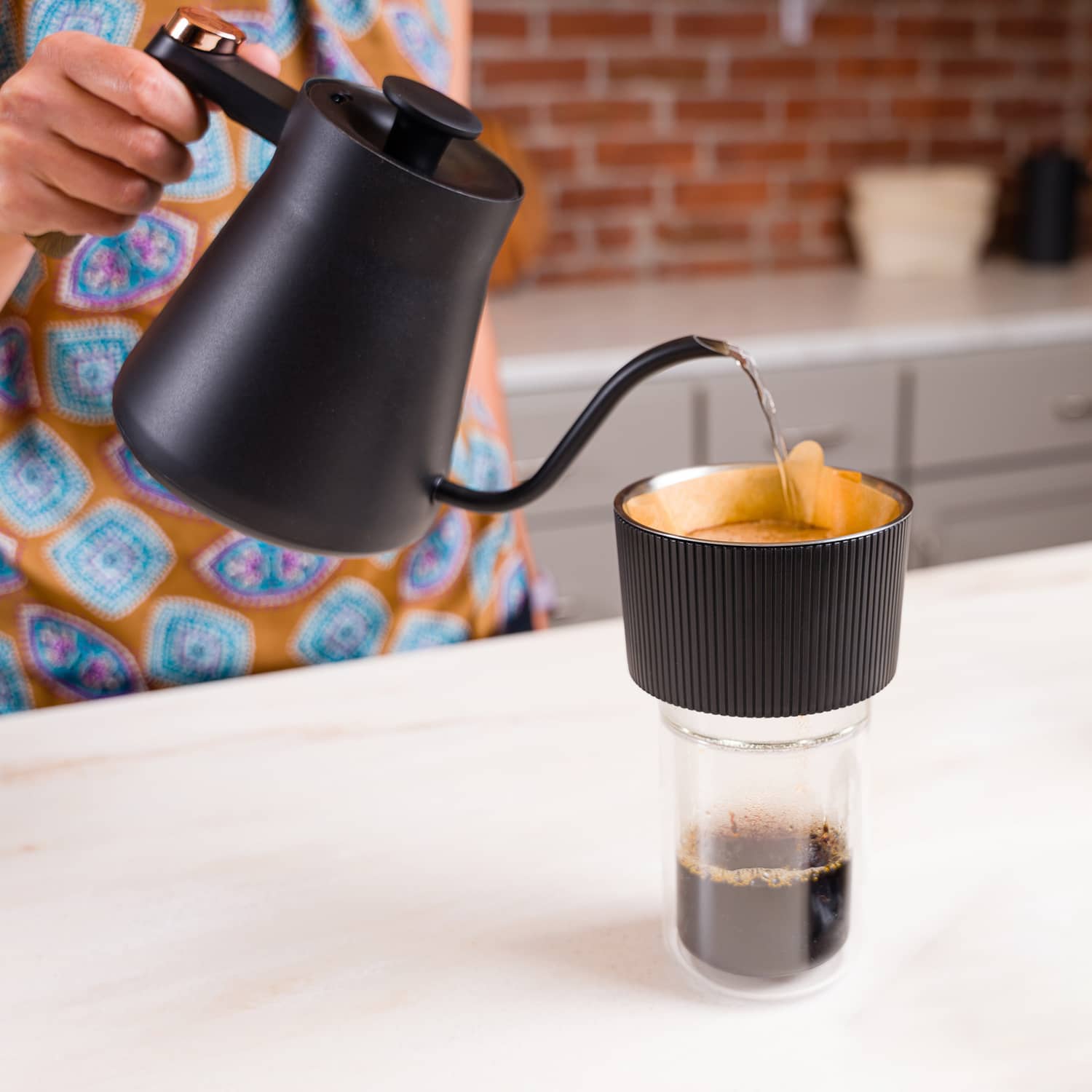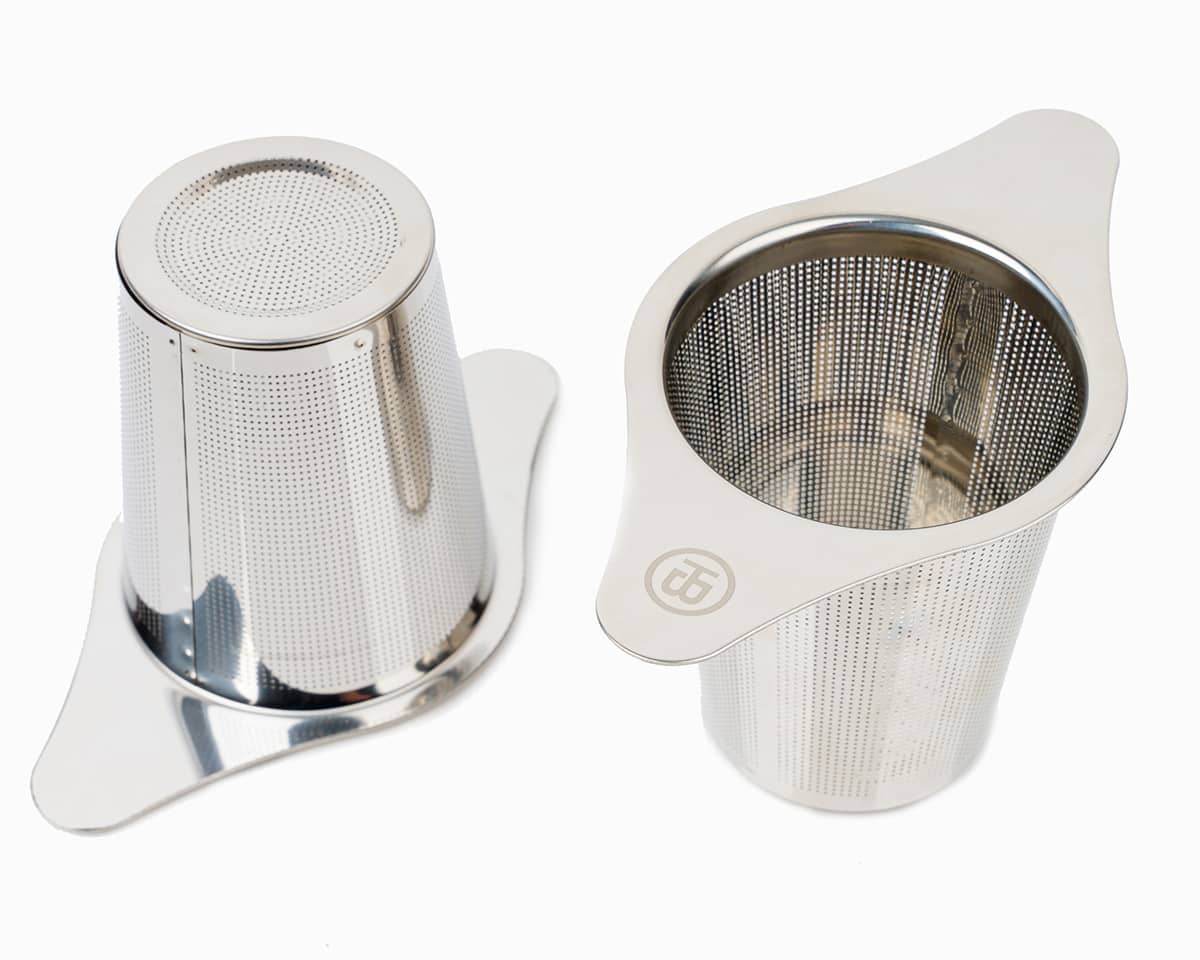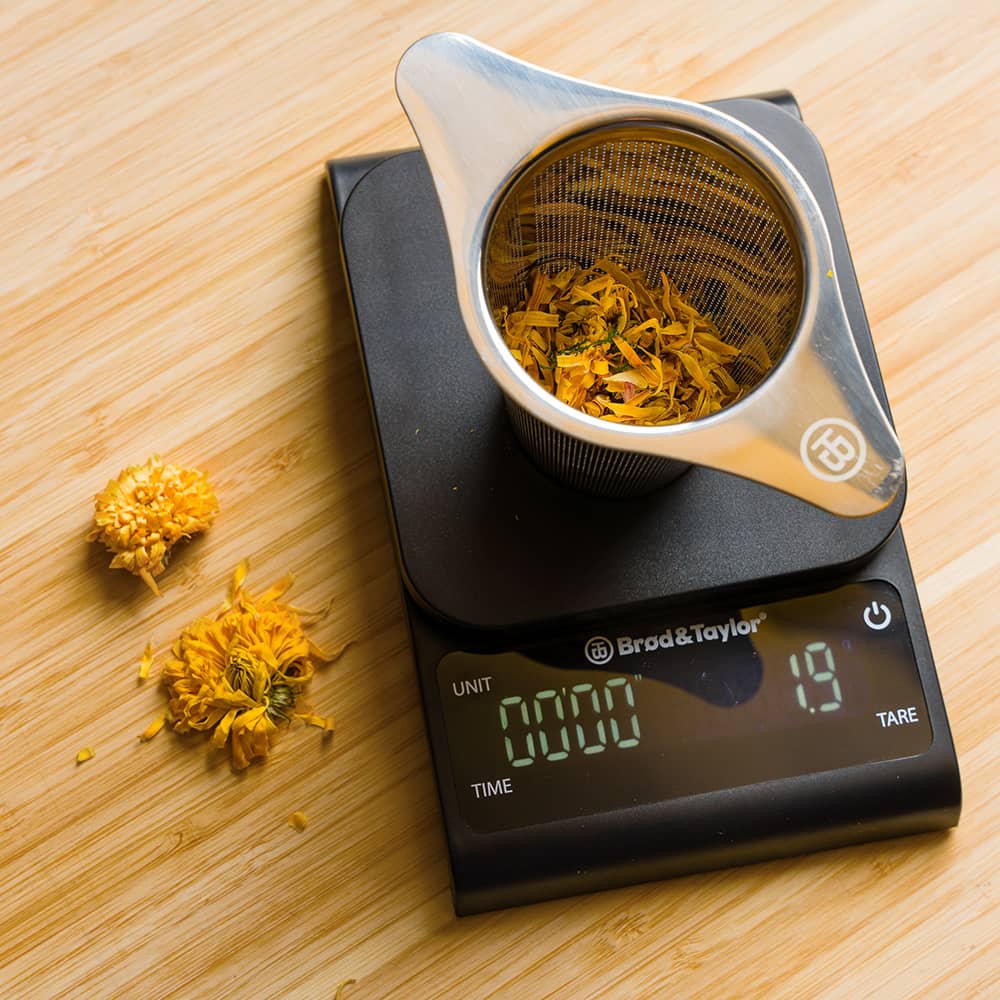How to Brew Professional Quality Coffee & Tea at Home

Making good coffee and tea at home shouldn’t be intimidating—or expensive. Equipped with the right supplies and understanding of a few simple steps, you’ll be on your way to brewing a hot beverage like a professional. Not only will you save money at the cafe, but you will have the satisfaction of sipping a delicious cup anytime you like.
Great Coffee Starts with Freshly Ground Beans
Like most food, fresh, quality ingredients are best. And the best way to make good coffee at home is to grind your own fresh, whole coffee beans. That's because small pieces of food break down faster than large ones when exposed to oxygen. Therefore, grinding your coffee just before you brew protects the oxidation, freshness, and moisture content of your beans. It also allows you to control your coffee’s flavor and strength. Additionally, uniformly sized coffee grounds extract flavors and other characteristics from your beans at the same rate (while various sized coffee grounds extract at different rates). For consistent coffee, you need consistent grounds.

What Grinder Should I Use?
To grind your own beans, you’ll need your own grinder. But you don’t need to spend a lot of time or money to grind good coffee. An easy to use electric blade grinder will transform your brew in seconds. Convenient and fast, a simple blade grinder is also great for grinding herbs and spices, which also comes in handy when making your own tea leaves. Depending on your flavor preferences, you may want finer or more coarse grounds. To grind a finer coffee with a blade grinder, simply run the grinder longer by pulsing it. This will help to avoid overheating your beans as you grind them. For pour over coffee, we recommend grinding to a medium coarseness similar to sea salt.
Shop Coffee Grinder
Pour Over Coffee
Compared to other methods, pour over coffee brewing has a balanced flavor clarity that is unmatched. That’s because extraction variables—coffee grounds size, water temperature, timing, and the speed at the grounds are saturated—are all within your control. By changing up these variables, you can change the taste of your coffee. Plus, the ritual of manually making coffee is itself a mindful way to start your day.
Grind Coarseness
Because pour-over coffee includes a paper filter, you're much less likely to get any grounds or sediment in the coffee. Compared to a french press, the grind size can be smaller and doesn't have to be quite as uniform. However, there is a limit to how fine the grind is: over-extracted coffee made from grounds that are too fine can create a bitter, hollow taste. So the ideal is a medium grind – finer than sea salt, but coarser than table salt. For the filter - a typical compostable brown paper filter works great.
Weighing your Coffee
Using a scale to weigh your grind ensures the right coffee-to-water ratio for the pour over method. This will also improve the flavor of your coffee. We recommend starting with about 30 grams of coffee for every 350 grams of water. You can adjust this ratio for taste, using a little less water to enjoy a more nuanced, light-roast coffee.
Shop Coffee Scale
Temperature and Timing

Water temperature and time spent brewing may seem like two minor variables, but each can contribute greatly to making a better cup of coffee at home. Temperature affects the extraction of your coffee’s oils, acids, and caffeine. The hotter the water, the quicker the extraction and the more difficult to control your coffee’s flavor. Too cool and you risk under-extraction, which leads to a sour tasting coffee. For the ideal extraction, the National Coffee Association recommends heating good tap or filtered water to between 195 °F and 205 °F (about 90 °C to 97 °C). Keeping your coffee consistent also requires consistency in how fast and how much water you pour.
The first pour is known as the “bloom” because it saturates the grounds and allows the coffee to bloom. For best results, use a kettle that pours in a steady stream, such as a gooseneck kettle. A degree-by-degree water kettle also ensures an ideal water temperature. When pouring, move the kettle slowly in circles, working your way from the outer rim in toward the center of your grounds.
The Perfect Pour (Over)
A good scale is helpful for weighing the amount of water you’re pouring, while a built-in timer is useful in recreating the perfect process every time. Before you begin, put your entire pour over coffee set-up, including your freshly ground beans, on the scale and zero it. Watch your precision scale and timer as you pour, making sure you’re not pouring too fast or two slow. Stop pouring when the scale reaches 60 grams. Repeat three more times, for a total of four pours, following the weight and timing table below.
Suggested Weight and Timing for 350g Mug of Coffee
Start with 30 grams of coffee for 350 grams of water. You may need to adjust the amount of coffee, grind size, and/or water temperature as the best cup of coffee for you is ultimately a matter of personal preference.
| Step | Amount | Time |
|---|---|---|
| Bloom | 60g | Pour 15 sec, wait 30 sec |
| Second Pour | 90g | Pour 15 sec, wait 45 sec |
| Third Pour | 100g | Pour 15 sec, wait 45 sec |
| Final Pour | 100g | Pour 15 sec, wait 45 sec |


Pour Over Coffee Dripper
Crafted for a simple and consistent brewing experience. With a stainless steel dripper designed for optimalextraction and secured in a patented outer shell, theperfect cup of coffee is now within your reach.
Featuring:
• 304 stainless steel designed to make your daily coffee ritualpure and chemical-free.
• A non-slip rubber surface that anchors itself to every mug,cup and carafe.
• 100 Brod & Taylor natural, unbleached #2 filters included.
• Insulation to keep your brew hot and your hand cool.
• Dishwasher Safe.
• Patent Pending.

The French Press

For the coffee purist, a french press offers an elegantly simple brew – full immersion of the coffee for a robust finish. The grind should be a bit larger than for pour over, about the same size as kosher salt. With this coarser grind, fewer grounds will pass through the filter and create sediment – and the double filter that comes standard with our press helps with that too. For the amount, use our recommended chart below. With water at roughly 200 degrees F, pour and make sure the coffee is fully mixed with the water. Our double-wall insulated construction keeps the water from cooling during your brew. After 4 minutes, push the plunger down slowly and enjoy the elegance of your brew. With continued use, experiment by changing the time and water/coffee ratio to create your perfect brew.
| Brew Size (Amount of Water) | Coffee |
|---|---|
| 1 Cup / 8 oz / 237 mL | 3 Tbsp / 16 Grams |
| 2 Cups / 16 oz / 473 mL | 6 Tbsp / 32 Grams |
| 4 Cups / 32 oz / 946 mL | 12 Tbsp / 64 Grams |
A French Press is not just for coffee – it might be even better for tea.
Our French Press is a traditional one combined with a modern double-wall construction and uncompromising quality that doubles as a hot/cold 34oz carafe with the included accessory lid.
Keep reading for our guide on brewing tea below and even making teas at home.

Keep Drinks Insulated for the Best Results
You’ve mastered how to make good coffee at home—don’t let it go to waste. Not only beautiful to look at and built to last, double-wall insulated mugs keep drinks hot (or cold) without the outside of the mug getting too warm so you can keep your perfect cup of coffee or tea the ideal temp until the last sip.
Our sturdy, hand-blown borosilicate glass mugs are made with a double-walled construction to keep drinks insulated (rated from -30°C to 530°C). They are also dishwasher-safe.
Shop Glassware
How to Make the Best Homemade Tea

Cooking with herbs, fruits, and spices may be second nature, but we often forget that using these fragrant ingredients in beverages can be just as enjoyable. Creating your own tea blends at home can benefit you even further. Store-bought herbal teas are often high-quality but expensive or poor-quality and filled with artificial flavors and other unnecessary additives. When you make your own tea at home you ensure superior flavors, quality, and affordability.
Mesh Tea Infuser Basket

Crafted with polished stainless steel and precision micro-holes, our Mesh Tea Infuser Basket provides a quality, efficient way to steep your favorite teas.
Small enough to fit in most mugs and teacups, but big enough for teas to expand, circulate, and steep effectively.
Featuring:
• Stainless steel designed - durable, reusable and easy to clean.
• 5-ounce basket - sized to allow tea leaves to unfurl for optimal flavor.
• Ptrvision micto-holes - 0.5mm fine mesh pattern ensures that everything is secured in the basket, avoiding any unwanted particles in your cup.

dummy text for
the height
How can I Dehydrate my own Teas?
Dehydrating at home is easy, it just depends on dehydration time and temperature. These will differ based upon what you are dehydrating. Look to your garden and farmer’s market for fresh, seasonal ingredients, and refer to the guides below for our recommended dehydrator settings as well as combinations for our favorite herbal tea blends..
How to Make Your Own Herbal Tea Blends
Read our guide for homemade herbal tea blends. When you make your own tea at home you can save money, experiment with flavors, and ensure superior quality and affordability.
Herbs
Lavender, chamomile, peppermint, rosemary, lemon thyme… The options for using dehydrated herbs in your homemade tea blends are endless. Herbs have calming properties and can benefit your immunity, digestive system, and overall health. Each herb is different (for chamomile you’ll want to use the flowers, but the buds for lavender). So for optimal results, research the best practices to harvest and prep the particular herbs you wish to use.

Fruit
Fruit used in tea is naturally sweet, full of flavor, and caffeine-free. It is packed with vitamins and antioxidants, especially citrus fruits which are an excellent source of vitamins C, A, and B. Oranges, lemon, apples, berries, and even black currant leaves make for delicious dehydrated additions to homemade tea blends. Fruit is often combined with white tea because its milder flavor pairs better than with a green tea, for example. Ginger (dehydrated or fresh) also pairs well with fruit tea blends.

Spices
Spices are the final flavor accent that will bring together your homemade tea blend. Potent and fragrant, a little bit of spice often goes a long way. Cinnamon, cardamom, cloves, fennel, and coriander are a few of our favorites to give your cup a kick.


dummy text fo
the height
Should I Measure my Teas?
Using a precision scale will not only help you recreate your preferred blend ratio, it is also handy in measuring tea leaves for each cup of tea. The suggested amount of loose tea leaves for a cup of tea is 2 grams per 8 ounces of water. Two grams is approximately 1 Tablespoon, but you will find that different types of herbs, fruit, and spices have different weights and size, which can vary greatly between blends. When brewing an individual cup or pot of tea, measuring your dry tea with a scale will ensure that you recreate the perfect cup of tea with your ideal flavor profile time and again.
Shop Precision Scale
Do I Need a Dehydrator?
If you want to create your own dehydrated tea blends, you will benefit greatly from using a dehydrator. Dehydrating herbs and fruit for tea is fast, tastes significantly better than store-bought dried ingredients, reduces food waste at home, and uses less electricity than oven drying. The Sahara Folding Dehydrator is the perfect machine for your home kitchen. Its simple-to-use dual time/temperature control ensures delicate foods like herbs are adequately dried without compromising flavor and texture, while patented dual sensors and heaters provide plenty of steady power for even the largest loads of fresh fruit.
Shop Sahara Dehydrator
Silicone Mats
Our reinforced silicone mats are excellent for holding small ingredients, such as herbs and berries, that might otherwise fall through the dehydrator shelves. Oven safe, dishwasher safe, and free from PTFA and BPA, these durable mats can also be used instead of parchment paper to line baking trays.
Shop Silicone Mats










